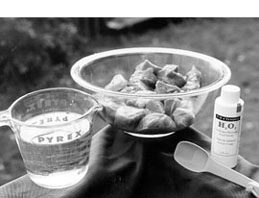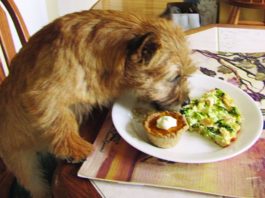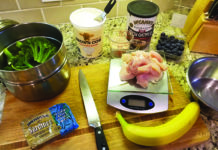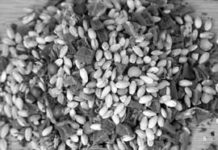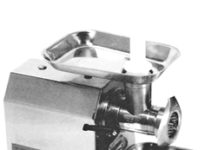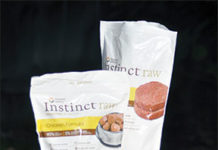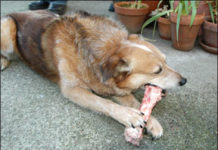More On Frozen Foods!
50808
Raw Dog Food and Salmonella Risks
Thanks to dogs' industrial-strength digestive systems, their strong stomach acids usually disarm the Salmonella bacteria before they can cause illness. And even if enough of the bacteria survive and manage to take up residence in the dog's digestive tract, he may well be completely asymptomatic; not all canine carriers of Salmonella become ill. This makes it difficult to know how widespread Salmonella infections are in the canine population.
Rolled-Up Welcome Mat?
No good deed goes unpunished. That’s what Pam Rowley of Upper Brookville, New York, discovered last November, when the hospital administrator who always greeted her and 8-year-old Vizsla Gunner at the start of their monthly therapy-dog visits quietly took her aside to deliver some bad news.
Calcium in Homemade Dog Food
If asked the most common mistake people make when feeding their dogs a homemade diet, I’d have to say that it’s not adding calcium....
Raw-Fed Puppies
When dog lovers switch their pets from commercial food to a well-balanced, raw diet, they typically report improved health, brighter eyes, a shinier coat, calmer behavior, and easier yard cleanup chores. A puppy's first eight weeks set the stage for a lifetime of health or illness, so it isn't surprising that puppies weaned on raw food grow up to out-perform dogs weaned on kibble or canned food, even if both are fed raw food as adults. Raw-weaned puppies nearly exhaust their breeders' vocabularies, for these are the healthiest / strongest / liveliest / calmest / smartest / most wonderful pups that ever lived.
Semi-Homemade Dog Food
We frequently write about kibble and canned dog food, but have neglected some of the less common (but no less worthy) types of commercial foods. Here’s a look at commercial products that make it easy to feed a home-prepared diet. In our reviews of dry and canned foods, we make specific recommendations for selecting products for your dog. We’re not going to do this here; instead, we simply want to inform you about these alternatives to conventional kibble and canned food, and describe the differences between them.
Raw Meat-Based Dog Food Diets
There are some very high-profile illnesses that can result from handling raw meat – scarifying things like E. coli, salmonella, and trichinella. The mere idea of these threats prevents many people interested in “raw feeding” from giving this type of highly beneficial diet a try. So, we’re going to demystify everything that could go wrong with raw meat (but probably won’t). We’ll describe some horrible diseases, and how they would affect a person who got them, and how they would affect a dog.
Best Food Grinders Used For Home-Prepared Dog Food Diets
People who are interested in feeding a home-prepared diet to their dogs often delay the transition as they grapple with various concerns. Frequently, they have come to believe the claims that a home-prepared diet offers dogs superior nutrition and can result in increased health and vigor . . . but they are still beset by fears that their dogs will suffer a broken tooth or perforated intestines caused by eating raw bone fragments.
Frozen Raw Meat-Based Dog Food Diets
There are thousands of dog guardians who feed their dogs homemade BARF-based diets, buying all the ingredients and preparing their dogs’ meals from scratch. People who utilize home-prepared diets are happy to discuss the many benefits of this feeding method for their dogs, including clean, tartar-free teeth; fresh breath; strong bones, muscles, and joints; a glossy coat; a healthy amount of energy and a balanced temperament; and overall vibrant good health. For all the people who have made the leap to a homemade, meat-based diet for their dogs, however, there are many more who would like to make the change, but who are intimidated by the challenge of “getting it just right.” Some are afraid of failing to present their dogs with a balanced array of nutrients; others fear bacterial contamination from handling raw meats.
New Challenges for Commercial Raw & Frozen Food Producers
People who believe in the value of feeding their dogs a biologically appropriate diet, comprised largely of raw meat and bones – with other foods added only to ensure that all their nutritional needs have been met, not as lower-cost “fillers” – love frozen raw diets. Food that has been formulated to meet the nutrient standards for a “complete and balanced” diet, and made with (mostly) meat and bones from (often) sustainably raised and humanely slaughtered meats, with the balance comprised of (frequently) organic, local produce . . . What’s not to like? The answer depends on who you are.
Raw Food Diet Does the Trick
When Deanna Cuchiaro of Whitehouse Station, New Jersey, set out to adopt an Irish Setter, she had no idea the rescue would change her entire perspective on animal health care. Cuchiaro already had one Irish Setter, Brandy, who had recently turned 10, and she wanted to get another so that Brandy could help pass his positive influence around the house to the newcomer. She considered getting a puppy, but decided to adopt a rescue dog from the Irish Setter Club of Central Connecticut rescue program. She met representatives of the rescue group at a local Irish Setter show who told her there was a large two-year-old male Setter available for adoption.
Home-Prepared Dog Food
including ground meat



